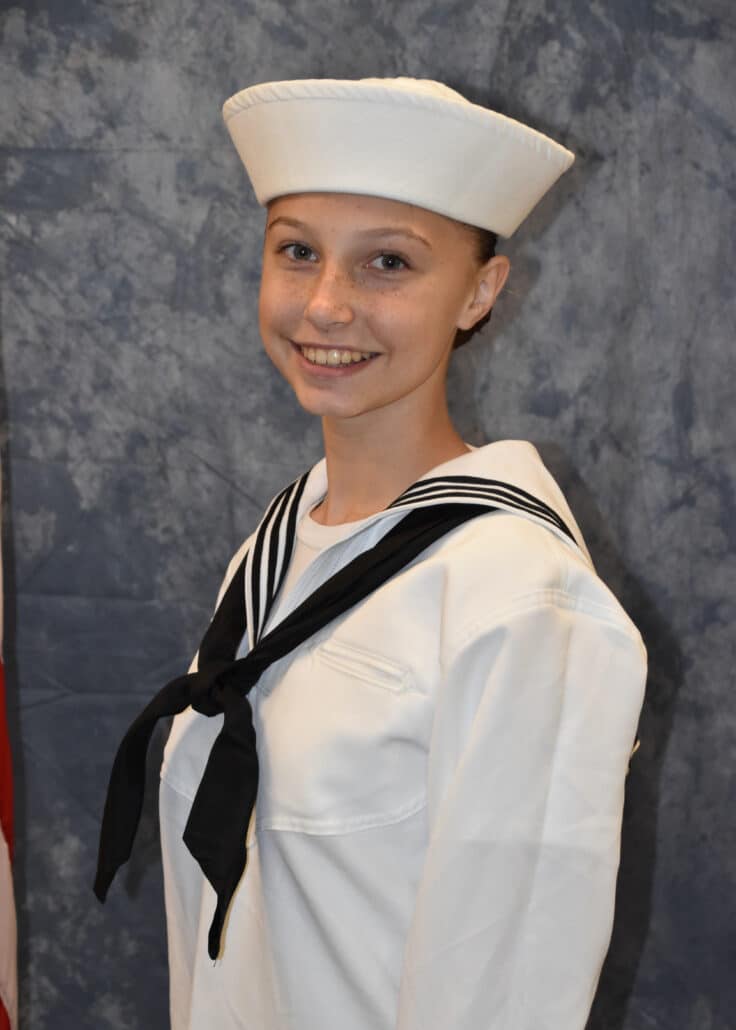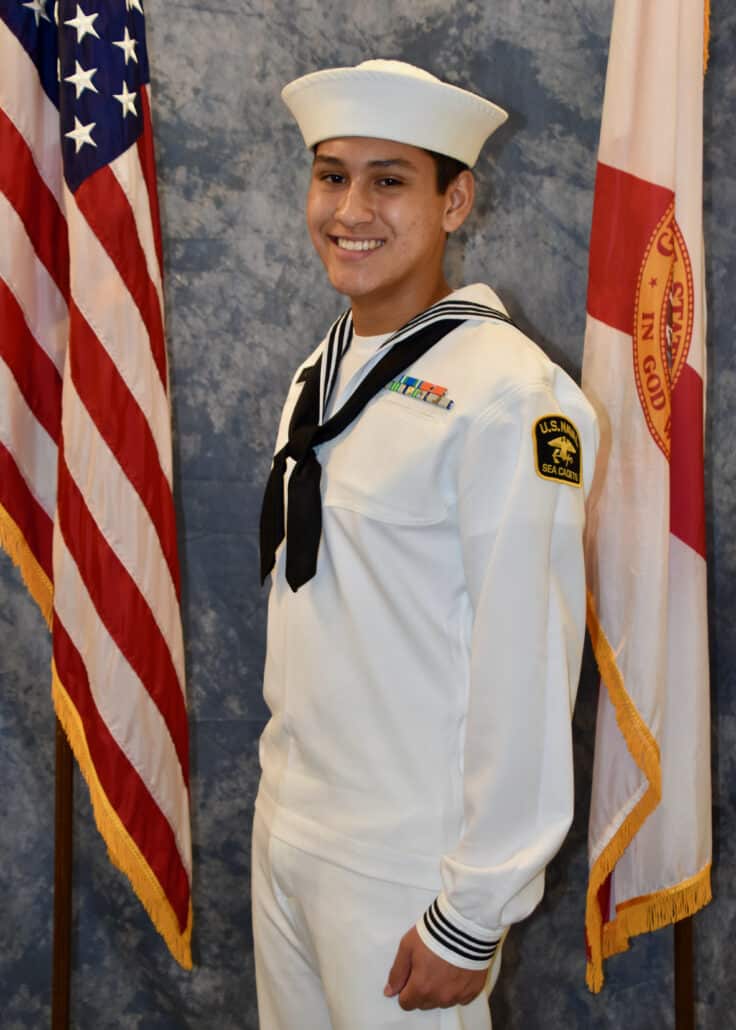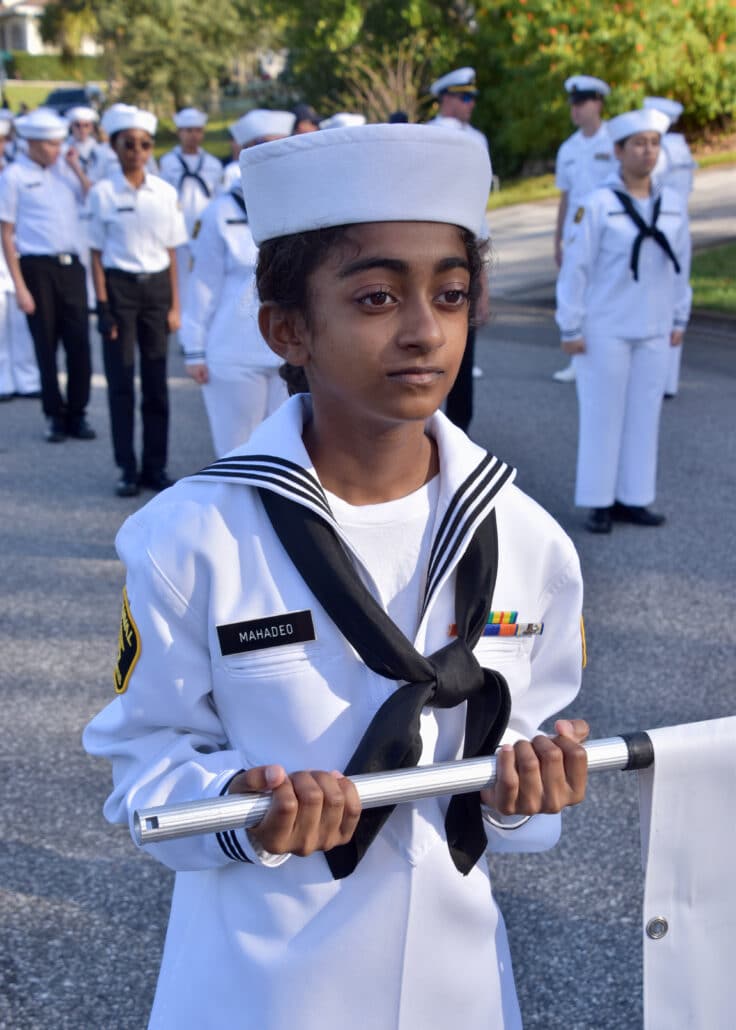What is the Naval Sea Cadet Corps (NSCC) and the Navy League Cadet Corps (NLCC)?
At‐A‐Glance: The U.S. Naval Sea Cadet Corps (USNSCC) is a federally‐chartered non- profit youth organization for young people, ages 10 through 17. The USNSCC comprised two programs. Our senior program, the Naval Sea Cadet Corps (NSCC), is for young people, ages 13 through 17, who are interested in developing their skills in leadership, basic seamanship, courage, self-‐reliance and discipline. Our junior program, the Navy League Cadet Corps (NLCC), introduces young people, ages 10 through 13, to naval life through instruction in basic seamanship and leadership.
The Navy League of the United States established USNSCC in 1958 at the request of the Department of the Navy to “create a favorable image” of the Navy on the part of American youth, Navy and Coast Guard. Their local Navy League councils sponsor the individual units by other local organizations.
Will I be required to join the U.S. Armed Forces as part of being a cadet?
No, we are not a recruiting vehicle for the armed services. Cadets have absolutely no commitment regarding future military service.
I want to enlist in the military after high school. How can being a Sea Cadet help me?
For those cadets who decide to enlist in the military (any branch of service, not limited to the Navy), their prior training as a Sea Cadet may allow them to join at an advanced pay grade. This means that a cadet who enlists may be eligible for a higher rank and pay than his or her non‐cadet counterparts. Cadets who choose to enlist in the military are more inclined to do better and stay in longer. Each cadet who enters the armed services is a disciplined, well-trained individual who typically adjusts better to the rigors of military service than those with no experience.
I want to apply for a service academy or another officer commissioning program after high school. How can being a Sea Cadet help me?
Being a Sea Cadet can help individuals become more competitive in certain programs. More than 10% of this year’s entering class at the U.S. Naval Academy were former Sea Cadets. Every year, many Sea Cadet graduating high school seniors are accepted into ROTC or OCS programs around the country. We can attribute some of this to the unparalleled experience received as a Sea Cadet.
What are the requirements of membership?
All prospective cadets must be U.S. citizens, who meet our minimum age requirements (ages 10 through 17). Cadets must be committed to being a drug-‐free, unmarried, full-‐ time student with at least a “C” grade point average. Cadets must also have parental consent to join the program. We are looking for cadets who are interested in contributing as much as possible to the program by attending drills and upholding our standards of conduct.
A medical examination similar to a high school sports physical is required for all cadet applicants to the NSCC or NLCC. No one will be denied admission to the NSCC/NLCC due to a medical disability. Where a medical condition precludes full, unlimited participation, the parent or guardian may present a Request for Accommodation for review, so the cadet may participate in NSCC activities to the maximum extent possible.
Record of Immunizations.
- The USNSCC requires all potential cadets to submit a current record of all immunizations, on any form provided by the family physician or state department of public health.
- All applicants and cadets must demonstrate compliance with the current recommended immunization schedule (including, if applicable, a catch-up schedule) issued by the U.S. Centers for Disease Control and Prevention (CDC).
- In order to minimize the risk of transmitting communicable diseases within the tight, shared living conditions at most USNSCC training evolutions, and in light of the possible presence of immunocompromised individuals enrolled pursuant to an approved Americans with Disabilities Act accommodation, the USNSCC is unable to — and will not — grant waivers to this policy for personal, religious or other non-medical reasons.
Can anyone join?
We welcome all applicants who meet the above membership requirements. The U.S. Naval Sea Cadet Corps will never discriminate based on race, sex, color, religion, national origin or disability. It is very important to us to promote a culture of inclusion in our Sea Cadet family.
Will I have to pay membership fees?
Yes. The $300 initial enrollment fee and $200 re-enrollment fee include premiums paid toward the Sea Cadet Group Accident and Health Protection Plan. Our insurance plan provides coverage if something happens during a cadet-sponsored training. This is a secondary plan, to cover after the Cadet’s personal insurance meets its limit. It is important to us that the membership fees are minimal in order to be accessible to as many people as possible.
The fee for enrolling for a year is determined by several factors: the cost of the program’s running and the cost of NHQ’s administration; Our local cadet corps unit is run by an all‐volunteer force.
What kind of uniforms will I wear?
Cadets are authorized by the Secretary of the Navy to wear official U.S. Navy enlisted uniforms appropriately marked with the NSCC/NLCC insignia.
Do I buy my own uniforms?
Surplus U.S. Navy uniforms are made available to the NSCC and NLCC. These uniforms, in turn, are then made available to cadets at a minimal cost. Uniform needs that cannot be met through this source may be purchased at Navy Exchange Uniform Shops. The uniforms are property of the USNSCC Clermont Battalion and must be returned upon departure from the program. Replacement fees will be charged for any items lost or not returned in serviceable condition.
How much time will my cadet training require each month?
Time commitment varies from unit‐to‐unit, but a typical unit will meet for one weekend a month, called a drill weekend. The Clermont Battalion does not operate overnight drill weekends unless it is an overnight camping or some other type of extended training weekend. Typical drill weekends Saturday AND Sunday, 0730‐1500 hours. Cadets are required to maintain at least 75% attendance at all drill weekends. Failure to meet attendance requirements, limit a cadet’s promotional opportunities and could jeopardize a cadet’s standing within the unit. Additional training opportunities of varying lengths are often made available throughout the year.
What do cadets learn?
Cadets join and meet monthly with their local unit, participating in a variety of classroom and outdoor training events, as well as community service activities. During school vacations, cadets participate in one‐ and two‐week training evolutions around the country where they learn lifelong skills and how to become leaders in their units, schools and communities.
Cadets study a broad range of subjects, all of them designed to enhance the individual. Some sessions, like community service, are designed to help them become better citizens, while other classes will teach them the importance of strong maritime forces. Cadets will study naval history, customs and traditions, seamanship, navigation and STEM subjects. Some units participate in SeaPerch and/or CyberPatriot programs as well as competitive pistol shooting teams.
Who instructs cadets?
Cadets are instructed by naval personnel (active duty, reserve and retired), by senior cadets, by dedicated adult volunteer leaders who make up the USNSCC Officer Corps, and by a variety of qualified guest speakers.
Are there advanced training courses for cadets?
Yes. In addition to advanced training aboard naval vessels, Sea Cadets may attend advanced training evolutions such as airman training, SCUBA, STEM, medical, Seabee indoctrination, SEAL challenge, military law enforcement training, and Leadership Academy. League Cadets may participate in advanced training evolutions in subjects such as leadership, seamanship and boating safety.
Are cadets permitted to go to sea?
Yes. After completing recruit training and other required courses of instruction, many Sea Cadets can participate in advanced training aboard Navy and Coast Guard vessels ranging from small patrol craft to large nuclear powered aircraft carriers. While League Cadets are not permitted to go to sea for extended periods, they often participate in day cruises and tours.
What travel opportunities are available to cadets?
Sea Cadets travel to training sites all over the country during the summer training period. Additionally, outstanding Sea Cadets are selected to participate in the NSCC International Exchange Program. We select exchange cadets on a merit basis; each cadet must have an outstanding record as well as good standing within his or her home unit.
What are the main differences between the training experiences of the NLCC and the NSCC?
The training program designed for League Cadets is age‐appropriate and less rigorous than that of the NSCC. It is less arduous, but still includes a wide variety of training opportunities designed to give League Cadets exposure to Navy life.
When joining the Naval Sea Cadet Corps, cadets are required to have attended an away- from‐home recruit training in order to rise in rank and participate in advanced training sessions. League Cadets have the option to attend an away-from-home orientation, but it is not a requirement for rank advancement.


